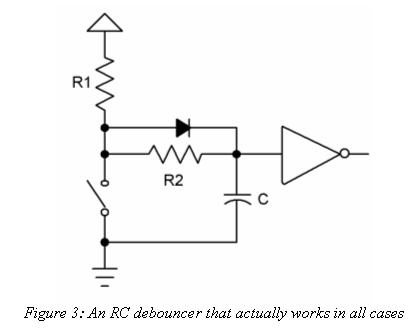Follow along with the video below to see how to install our site as a web app on your home screen.
Note: This feature may not be available in some browsers.

What you didnt read your own link??
"The diode is an optional part needed only when the math goes haywire. It's possible, with the wrong sort of gate where the hysteresis voltages assume other values, for the formulas to pop out a value for R1 + R2 which is less than that of R2. In this case the diode forms a short cut that removes R2 from the charging circuit. All of the charge flows through R1. The previous equation still applies, except we have to account for drop across the diode. Change Vfinal to 4.3 volts (5 minus the 0.7 diode drop), turn the crank and R1 pops out."
Why would I need to provide explanation, I simply showed one of the hardware configurations mentioned in the article you linked to which I had stated. What prompted me to do this was that Colin told the OP all he needed was a cap across a switch, which left out some of the components which I think are needed. In fact I take your response to my last post #4 as being snarky. You did the same thing to me on another thread I made about a website that compared vendor prices such as Mouser vs Futurelec, Digi-key etc. I posted the info to help others and what I got from you was some snotty response. It seems that if you take a disliking to someone, you then go out of your way to make that person look foolish.Unfortunately, Mikebits didn't provide any explanation for the diode in the generic circuit he recommended, nor did he give sufficient information to calculate whether the diode was needed.
I have never written a debounce routine for buttons. I write code for safety products.. never needed a debounce routine for a button.
I think I get what you mean, Pommie did some code for the junebug and servo's, in it there was a routine for telling which button was pressed, while it wasnt a debounce routine it did the job well for debouncing.I have never written a debounce routine for buttons. I write code for safety products.. never needed a debounce routine for a button.
So are you saying you use a hardware method instead of a software?
